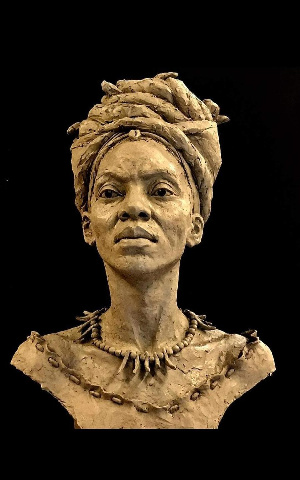They are Queen Yaa Asantewaa, Queen Nanny of Maroon, and Queen Abla Pokou of Baoule Kingdom.
GhanaWeb today highlights Queen Nanny of Maroon, her achievements, and how the Jamaicans celebrate her in the month of February under Black History Month.
According to reports, Queen Nanny was born in 1686 in Ghana and died in 1733 in Jamaica.
Blackpast.org explained that Nanny also known as Granny Nanny, Grandy Nanny, and Queen Nanny was a Maroon leader and Obeah woman in Jamaica during the late 17th and early 18th centuries. Maroons were slaves in the Americas, who escaped and formed independent settlements.
The portal adds that “Nanny herself was an escaped slave who had been shipped from Western Africa. It has been widely accepted that she came from the Ashanti tribe of present-day Ghana.”
History has it that, she fought and freed over 800 slaves on the island of Jamaica, for over 30 years. There are many stories about her, it is said she was a queen in Ghana from the warrior Ashante tribe when she was captured and brought to Jamaica where she later escaped and led an armed revolt against the British Empire in the mountains and jungles of Jamaica for two decades.
In a post on the Facebook page of The Black Kings & Queens Project, “it is said she used guerilla warfare to fight the British who suffered great loss and later settled with a peace treaty to spare their men.”
“She was said to also be a powerful spiritual voodoo priestess who would use her powers to shield her fighters from the attacks of the British. One British officer who was lucky to survive her encounter described her as being small, muscular, and strong with intense eyes. She wore a girdle with at least 10 different combat knives. Queen Nanny is Jamaica’s only female hero and there are still Maroons living in Jamaica today.”
In Jamaica, her life and accomplishments have been recognized by the Government of Jamaica. She has been honoured as a National Hero and awarded the title of “Right Excellent”.
Currently, there are only seven such National Heroes in Jamaica and Nanny is the only woman. A modern portrait of Nanny, based on her description, appears on the Jamaican $500 note, the largest banknote in circulation in Jamaica.

Read below a profile put together by blackpast.org below:
Nanny and her four brothers (all of whom became Maroon leaders) were sold into slavery and later escaped from their plantations into the mountains and jungles that still make up a large proportion of Jamaica. Nanny and one brother, Quao, founded a village in the Blue Mountains, on the Eastern (or Windward) side of Jamaica, which became known as Nanny Town. Nanny has been described as a practitioner of Obeah, a term used in the Caribbean to describe folk magic and religion based on West African influences.
Nanny Town, placed as it was in the mountains away from European settlements and difficult to assault, thrived. Nanny limited her attacks on plantations and European settlements and preferred instead to farm and trade peacefully with her neighbors. She did however make numerous successful raids to free slaves held on plantations and it has been widely accepted that her efforts contributed to the escape of almost 1,000 slaves over her lifetime.
While Nanny lived, Nanny Town and the Windward Maroons thrived and multiplied. The British colonial administration became embarrassed and threatened by the successes of the Maroons. Plantation owners who were losing slaves and having equipment and crops burned by Maroon raiders demanded that colonial authorities act. Hunting parties, made up of British regular army soldiers, militiamen, and mercenaries (many from the free black community), scoured the Jamaican jungles.
Captain William Cuffee, known as Captain Sambo, is credited as having killed Nanny in 1733 during one of the many and bloody engagements of the war. The war itself lasted from 1720 until a truce was declared in 1739; Cudjoe, one of Nanny’s brothers and a leader during the Maroon War, was the driving force behind the treaty. After Nanny’s death, many of the Windward Maroons moved across the island to the more sparsely inhabited Western (or Leeward) side of Jamaica. Nanny Town was eventually captured by the British and destroyed in 1734.
Source: www.ghanaweb.com
 Home Of Ghana News Ghana News, Entertainment And More
Home Of Ghana News Ghana News, Entertainment And More





